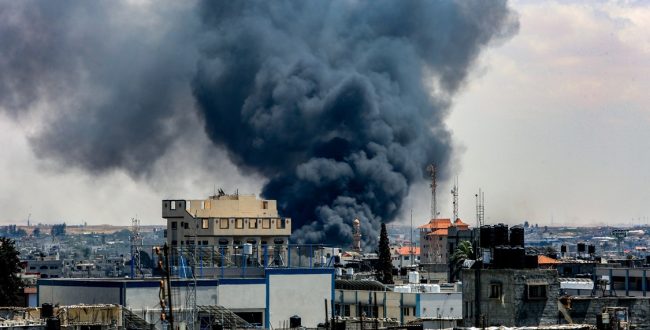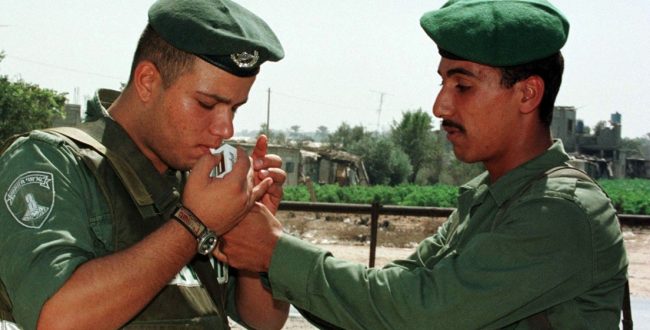The Islamic Resistance Movement – Hamas – was founded in late 1987, in response to the beginnings of normalization with Israel led by Arafat’s PLO. From the outset, in article 2 of its charter, Hamas declared itself both the Palestinian arm of the Muslim Brotherhood and a “unique Palestinian” movement.
This duality, staying loyal to a transnational organization while remaining a national liberation movement, has dogged Hamas ever since. Unlike the PLO, which since the 1980s has seen ties with moderate Israeli elements, and later official negotiations with the Israeli government, as key to achieving Palestinian national goals, Hamas has always believed in armed struggle. It has consistently worked to undermine the Oslo Accords since they were signed in 1993.
The movement registered its first political victory (along with other militant Palestinian groups) when Israel unilaterally withdrew from Gaza in 2005. Hamas leaders could now persuade Palestinians that in contrast to the PLO’s conciliatory approach – which had “liberated” 40% at most of the West Bank (Areas A and B) – the armed struggle had driven one of Israel’ most hawkish prime ministers, Ariel Sharon, to withdraw from the entire Gaza Strip in one fell swoop, removing 8,600 settlers. This achievement undoubtedly helped Hamas win the January 2006 general elections.
The movement celebrated its second major victory in October 2011, when the Shalit deal was completed. Having abducted Israeli soldier Gilad Shalit on the Gaza border in June 2006 and held him hostage for five and a half years, Hamas negotiated a prisoner exchange of stellar proportions for Palestinians: Israel released 1,027 prisoners, including hundreds serving life sentences for murdering Israelis. Some of Hamas’ current senior leaders, including Yehya Sinwar and Husam Badran, were released as part of the deal.
The Islamic Spring
The wave of unrest that began in Tunisia in December 2010 and swept through the Arab world, earning the nickname “the Arab Spring”, had a profound impact on Hamas. In many countries, the protests gave voice to popular movements previously silenced by authoritarian regimes, chief among them being the Muslim Brotherhood. The Hamas political leadership, which was based in Damascus when the protests broke out in southern Syria in March 2011, quickly found itself called upon to take a stand on the Assad regime, which had backed militant Palestinian factions, including Hamas itself, since the 1970s. Assad’s violent suppression of the demonstrations, which were led by Syria’s Sunni-Muslim majority, drove Khaled Meshaal, Hamas’ political bureau chief, to move to Qatar in January 2012. Deserting its Syrian patron cost Hamas the support of Iran, which had provided the movement with weapons and funding.
Yet Hamas was quickly rewarded for betraying the Syrian-Iranian “axis of resistance” by a quick succession of regime changes set in motion by the Arab Spring. The ousting of Tunisian president Zine El Abidine Ben Ali led to general elections in October 2011, ending with a landslide victory for the Ennahda party under Rached Ghannouchi, who is affiliated with the Muslim Brotherhood. In Egypt, President Hosni Mubarak’s resignation in February 2011 (after a sixteen-month military regime) led to a general election won by the Muslim Brotherhood. In June 2012, Mohammed Morsi was voted president in the first free elections ever held in Egypt. In Morocco, the Islamic Justice and Development Party (PJD) won the vast majority of seats in the November 2011 elections, and party leader Abdelilah Benkirane became head of a three-party coalition. In post-Gaddafi Libya, the Justice and Construction Party (JCP), founded when the revolution began, came second in the national elections.
Hamas leaders, identified with the Syria-Iran axis until the Arab Spring, became guests of honor in Cairo, Tunis and Khartoum. Hamas saw its success in the Palestinian 2006 elections as the precursor to Islamist victories throughout the Arab world in the following years. However, as Khaled Meshaal noted in 2016, Hamas also suffered anti-Islamist resistance (a “counter-revolution”, in his words), as did the other new Islamist regimes.
The most important political outcome of the Islamist wave was in Egypt. On June 30, 2013, demonstrations began throughout the country, demanding that President Mohammed Morsi resign following a series of controversial proposed amendments to the constitution. The military gave Morsi a 48-hour ultimatum before implementing its own “road map” for Egypt. Two days later, Morsi was overthrown by a coalition made up of the military, the secular opposition and the Coptic church. In Tunisia, the liberal, secular Nidaa Tounes party, backed by the labor unions, overcame the Ennahda party in late 2014. Beji Caid Essebsi, who had served as minister of foreign affairs under Ben Ali in the 1980s, became Tunisia’s first president to be directly elected.
In other words, the Arab Spring signaled to Hamas that the Muslim Brotherhood could rule Arab countries, while the “counter-revolutions” showed that any Islamist government would have to deal with domestic and foreign opposition and with essential challenges regardless of other actors. Whether it was the conduct of Islamist forces once they took over (confrontational in Egypt, inclusive in Tunisia) or the military’s desire to maintain power along with “deep state” mechanisms, the Islamist experiment in Arab countries was short-lived.
The new Arab regimes leveraged the public aversion to radical Islam associated with ISIS and identified the political Islam represented by the Muslim Brotherhood with Jihadi nihilism. In an interview with Kuwaiti newspaper Al-Shahed in October 2018, President Abdel Fatteh a-Sisi promised that as long as he remained in power, the Muslim Brotherhood would play no role in Egypt. “The chaos created by the Muslim Brotherhood has destroyed many Arab countries, such as Yemen and Libya,” he claimed. “The Egyptian people will not accept a return to power of the Brotherhood, because their ideology is unrealistic and at odds with real life.”
Mainstream Arab media toed the line with the new political trend of identifying ISIS with the Muslim Brotherhood. Newspapers that had actively supported the Islamist revolution quickly changed tack and started warning against the dangers of political Islam. In June 2018, Egyptian journalist Munir Adib published an op-ed in the pan-Arab London-based AL-Hayat. He argued that the Muslim Brotherhood had laid the foundations of popular support for ISIS in northern Sinai and even helped recruit militants. “The Muslim Brotherhood sees ISIS as a bridge for fulfilling its wishes by spreading anarchy throughout Egypt. The Brotherhood knows it cannot return to power by any means but anarchy”, wrote Adib.
The new document of principles
The failure of the Islamist governments forced Hamas into a reckoning, which found expression both in speeches by its leaders and in new policy steps. In an attempt to maintain good relations with Arab countries in the post-Islamist era, the movement released a new policy document in May 2017 cutting its historical ties with the Muslim Brotherhood. Unlike the 1988 charter, which mentioned the connection to the Muslim Brotherhood no less than seven times, the new document did not make a single mention of the transnational organization.
“We’ve learned our lesson from what’s happening around us”, admitted Khaled Meshaal frankly in a 2016 speech. “Not all the factors that affect us are objective. Some are the result of our own actions, and we must reach our conclusions accordingly.” Political Islam, he continued, has upheld democracy more than its “secular” opponents. Yet the real test will be whether its proponents continue to rely on the polling booth for political outcomes, even in tough situations which “indicate a policy of marginalization and de-legitimization.” On the other hand, “will they continue to work towards partnership and agreement, even when [the Islamists] have the support of the majority? That is the challenge.”
The document of principles was released as part of a media campaign aimed at presenting Hamas as a national liberation movement and distancing it from the antisemitic Islamist language of the charter. “Scrutinise the manifesto upon which we were elected to govern in 2006 if you really wish to understand the political vision of Hamas, not a charter drawn up decades ago and long forgotten,” wrote senior Hamas member Ahmed Yousef in a Guardian op-ed. According to Yousef, the movement’s willingness to relinquish absolute power in 2014 in favor of a Palestinian unity government proved its pragmatism. “Judge Hamas on the measures it takes for its people. Do not rely on the words of a document – the charter – written under entirely different circumstances”, he concluded. In another article, Yousef argued that Hamas must forge closer ties with world Jewry and try to convince them of its rationale.
The same pragmatism was voiced by Hassan Yousef, a founding member of Hamas and one of its foremost leaders in the West Bank, in an interview I held with him in July 2015, one day before Jewish extremists murdered the Dawabsha family in the village of Duma. He said that were Israel to withdraw to the 1967 borders and recognize Jerusalem as the Palestinian capital, Hamas and the other Palestinian resistance movements would lay down their arms. “In Islam, Jihad is not an end to itself, but a means to an end… If the occupation ended its behavior towards our people and recognized our rights, no Palestinian would want to see one drop of blood shed.”
Together with releasing the new document, Hamas waged an all-out war against Jihadi Islamist elements within Gaza. The goal was both to distance Hamas from the radical Islam that the Egyptian military is fighting in northern Sinai and to retain control within Gaza. In July 2015, Sheikh Issam Saleh, a Salafi leader in Gaza, called on Hamas to halt the wave of arrests against Salafi operatives and return their confiscated weapons. In 2017, Salafi movements in Gaza admitted to firing rockets at Israel in retaliation against Hamas for arresting their members. The assassination attempt against the head of Gazan security forces, Major General Tawfik Abu Naim, in October 2017 was also attributed by Israel to Jihadi movements in Gaza. The ISIS faction in northern Sinai explicitly threatened to target the Hamas leadership and even broadcast the execution of Hamas operative Musa Abu al-Zamat.
Hamas’ regional isolation, along with the harsh economic shocks of the Israeli siege and the Egyptian demolition of the smuggling tunnels, played their part in the movement’s turn towards pragmatism. In an interview with Palestinian daily Al-Quds in May 2017, the Hamas political bureau deputy chief, Musa Abu Marzuq, explained that the new document reflected a coming together to battle the disappearance of the Palestinian issue from center stage during the Arab Spring:
We are experiencing a difficult, extraordinary situation in the region, and an international assault upon the Palestinian issue. Our surroundings have given up on the major issue that concerns our people. This compels us to resist attempts to erase the “issue”. The Palestinian people – backed by the Arab and Islamic nation – can revive the Palestinian issue and force the occupation to surrender to their just demands. The movement released the document in order to emphasize the national responsibility [of Hamas], as a national liberation movement inspired by Islam, and in order to present a political vision that will serve as the basis for national cooperation. There can be no future for the national project if there is Palestinian division.
In an interview with the BBC following the release of the new document, the head of the central bureau at the time, Khaled Meshaal, claimed that Hamas’ agreement, stipulated in article 20 of the new document, to recognize a Palestinian state within the June 1967 borders with Jerusalem as its capital is “a joint program with our partners in the Palestinian sphere.” According to Meshaal, Hamas’ compromise on this matter will promote Palestinian unity and the document indicates “the development of Hamas’ political thinking over the last thirty years, and especially the last decade”. He added that the goal of the new intra-Palestinian agreement address regional neighbors and international actors in a unified voice.
Meshaal also claimed that Hamas is “moderate, represents the middle way and has a political platform. We are addressing the world with an open political language.” He said that while the movement’s original charter was “freely” phrased, Hamas had carefully considered the wording of the new document. Meshaal emphasized that although Hamas’ ideology is based primarily on that of the Muslim Brotherhood, it is “an independent national liberation movement.” In fact, this approach is not new among Hamas leaders. In an interview with the Muslim Brotherhood daily in Jordan in 2010, Meshaal stressed before his home audience that armed struggle is a means rather than an end. He also explicitly refrained from declaring that the aspiration to “liberate” territories referred to all the land previously under the British Mandate, from the Jordan River to the Mediterranean.
In an interview I held with him, Hamas political bureau member Husam Badran conceded that the desperate economic situation in Gaza, including a 50% unemployment rate, played a part in Hamas’ new flexibility. Badran, who used to head Hamas’ military wing in the northern West Bank and is currently in charge of liaising between his movement and other Palestinian factions, compared his party’s positions with those of Israel’s ideological right: both sides believe the entire land is rightfully theirs, but are willing to come to terms with reality and settle for less.
Summary
The Arab Spring sent Palestinian politics into a tailspin with which they are still struggling. The temporary rise of political Islam to power inspired Hamas to form new strategic alliances. However, the short-lived “Islamic Spring” also proved that nothing much is new under the sun: President Morsi’s government continued to defend Israel’s peace treaty with Egypt and waged war against Jihadi Islam in northern Sinai; the religious regimes in Morocco and Tunisia continued to treat local Jewish communities well and maintained functioning ties with Western countries.
The fall of these regimes left Hamas almost entirely isolated on the Arab front, with Qatar its sole ally. The destruction of the smuggling tunnels on the Egyptian border, coupled with Israel’s economic and political siege on Gaza, played their part in easing Hamas’ militant line. The movement began to seek out pragmatic solutions, while sticking to its declared basic principles. Hamas’ Updated stance is intended to soften the international community’s views on the movement, in light of the three demands posed by the Quartet (the US, Russia, the EU and the UN) after Hamas won the 2006 elections: recognizing Israel’s right to exist, accepting current Mideast peace agreements and non-violence.
At present, the international community is still boycotting Hamas for refusing to acknowledge Israel and agreements signed with the country. The movement’s ‘stock’ is at an all-time low, just as the PLO’s was after the First Gulf War. Back then, in the 1990s, Israel cleverly used the PLO’s weakness to force its hand into entering the Oslo talks. Israel must now seriously consider whether the time has come to buy Hamas stock at a low price.
















